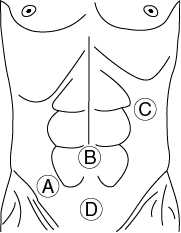-
The LPN/LVN reinforces teaching for a client after a right mastectomy and axillary lymph node dissection. Which statement by the client requires further intervention by the LPN/LVN? Select all that apply.
- “I will wear gloves and long sleeves while I am in my garden.”
- “The risk for arm swelling will decrease one year after my treatment is completed.”
- “I will sleep with my right arm elevated on a small flat pillow from now on.”
- “If my right arm begins to feel heavy, I should contact my clinician.”
- “It will be necessary for me to wear a compression bandage for the rest of my life.”
-
The LPN/LVN prepares to reinforce instructions for a client about the use of an incentive spirometer. Arrange the following steps in the order the client should perform them. All options must be used.
- Seal lips around the mouthpiece.
- Assume semi-Fowler’s or high Fowler’s position.
- Exhale slowly and cough.
- Hold breath for 3 to 5 seconds.
- Inhale slowly and deeply.
-
The LPN/LVN prepares to administer 1 liter of normal saline at a rate of 125 mL/hr. The drop factor for the intravenous tubing is 15 drops per mL. What is the drip rate per minute? Round to the nearest whole number.
- gtt/min
-
The LPN/LVN prepares to administer an intramuscular injection to a 6 month old. Identify the area where the injection should be given.
- A
- B
- C
- D
-
The LPN/LVN cares for a client diagnosed with Parkinson’s disease. The LPN/LVN observes that the client has tremors of the hands and slurred speech. The family reports that the client appears depressed. What is the PRIORITY of care for this client?
- Provide a clock and calendar in the client’s room.
- Encourage the client to perform range of motion exercises.
- Ask the family about the client’s favorite television shows.
- Assist the client to sit on the edge of the bed before ambulation.
-
The client is waiting to be picked up by family members after a cystogram in the urologist’s office. Which of the following actions by the LPN/LVN is appropriate teaching about the client’s home care for the first 48 hours? Select all that apply.
- The client should decrease water and other fluid intake.
- The client should avoid alcoholic beverages.
- If the client has a slight burning sensation when voiding, the family should transport the client to the nearest emergency facility.
- If the client has any signs of blood in urine, the family should transport the client to the nearest emergency facility.
- The client can apply heat to the lower abdomen to relieve pain and muscle spasm.
- The client should report to the urologist any fever, chills, or increased pulse.
-
The LPN/LVN is caring for the client who has just undergone surgery for an inflamed appendix. The surgeon made a traditional incision directly over the organ removed. Identify the area where the nurse would check for bleeding and infection.
- A
- B
- C
- D
-
The LPN/LVN prepares to give the nonmobile client a bedpan. Arrange the following steps in the order that the nurse should perform them. All options must be used.
- Cover the client with bed linens for privacy.
- Help lift the client by placing one hand under the client’s lower back.
- Ask the client to flex the knees and raise the buttocks.
- Put on a pair of clean exam gloves.
- Raise the opposite side rail to prevent the client from falling out of bed.
- Place the bedpan on the bed so that the client’s buttocks rest on the rim.
-
The LPN/LVN is teaching the client assigned the DASH diet how to estimate sodium intake. The DASH diet limits daily sodium to 1,500 mg, which must account for sodium already in food as well as any table salt that is added. A quarter-teaspoon of salt contains 500 mg sodium. What is the maximum total amount of salt that the client could eat per day, in teaspoons?
- teaspoons
-
The LPN/LVN cares for the client diagnosed with possible liver damage following an automobile accident. Which of the following actions by the LPN/LVN reflects appropriate care for this client? Select all that apply.
- The LPN/LVN prepares for the client’s inability to bathe without assistance.
- The LPN/LVN makes sure the side rails are up at all times.
- The LPN/LVN reports the client’s nosebleed to the nurse manager immediately.
- The LPN/LVN reports the client’s constipation to the nurse manager immediately.
- The LPN/LVN removes the hospital bed pillow to help the client lie flat.
- The LPN/LVN assesses the client’s skin and eye color for signs of jaundice.

